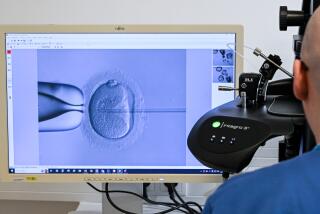California medical board revokes license of ‘Octomom’ doctor
- Share via
The medical ethics controversy that erupted when Nadya Suleman gave birth to octuplets two years ago took a decisive turn Wednesday when the California medical board announced it will revoke the license of the Beverly Hills fertility doctor who helped the single mother of six conceive eight more children.
The “Octomom” case focused national attention on what critics have called “the Wild West” of fertility medicine. And Dr. Michael Kamrava, who assisted Suleman by implanting her with 12 embryos, became a symbol to some of the problems in the burgeoning industry.
A six-person panel of the board ruled that Kamrava “did not exercise sound judgment” when he performed the embryo transfer in July 2008. Kamrava was accused of being grossly negligent in his treatment of Suleman and a 48-year-old patient who suffered complications after she became pregnant with quadruplets after receiving seven embryos.
Guidelines by the American Society of Reproductive Medicine say doctors should not normally implant more than two embryos in women under 35, and no more than five embryos in women over 40. Suleman was 33 when she gave birth to the octuplets.
The panel also found that Kamrava committed repeated negligent acts while caring for a 42-year-old fertility patient. In that case, he failed to flag an abnormal test result, and months later another doctor discovered that the woman had ovarian cancer, the panel noted.
“This is not a one-patient case or a two-patient case; it is a three-patient case,” the panel said. “Public protection is paramount.” The revocation takes effect July 1.
Taking away a physician’s license is rare in California, where there are 122,000 doctors with active credentials. In the last fiscal year, the Medical Board of California revoked just nine licenses on the grounds of gross negligence, which is defined as the “want of even scant care or an extreme departure from the ordinary standard of conduct.”
In its 44-page order, the panel offered harsh words for Kamrava’s care. The panel appeared particularly disturbed by his lawyer’s argument that Kamrava’s patients were partly responsible for having too many babies because they failed to terminate an excessive number of fetuses. The panel said the three patients sought out Kamrava “to create life and carry it into the world.” Reducing the number of fetuses they were carrying would have created risks “including the loss of all pregnancy,” the board said.
“To assign even a scintilla of responsibility to a patient who becomes pregnant and then elects not to follow through with a procedure that may jeopardize her (and possibly her family’s) prized objective is troubling and telling,” the panel said.
The panel also rejected the argument that bad publicity would deter Kamrava from transferring an excessive number of embryos in the future. The panel noted that Kamrava said the publicity surrounding the Suleman case distracted him from following up properly with another patient. “The board is not persuaded that relying on the public or media to fulfill or supplement the board’s public protection role is sound policy.”
The panel rejected the suggestion of an administrative law judge that Kamrava receive five years’ probation. Unless Kamrava successfully appeals his license revocation through the state court system, the revocation would mark the end of his medical career in California.
The octuplets were born in January 2009, and initially the news was greeted as a medical feat for the doctors and a joyous event for the family.
Then, details of Suleman’s life began to emerge, namely that she was a single mother living with her parents and receiving public assistance and that she already had had six children through in-vitro fertilization. The state would probably be picking up the costs for the birth of her babies, which experts estimated could easily reach seven figures.
The public turned on her in a fury. In the deepest part of the recession, she became a lightning rod for criticism of the nation’s healthcare woes, the economic crisis and the medical ethics of in vitro fertilization. Her publicists dropped her as a client after getting death threats.
And she became a tabloid sensation.
Dr. Phil had her on his show repeatedly, to “make Nadya understand” what she had done, he said. The gossip websites TMZ and Radaronline chronicled her every move, and Radar paid to let cameras into her chaotic home.
Through it all, the tiny babies thrived, surprising medical experts with their health.
Suleman, meanwhile, struggled financially. Many of the predicted reality television deals failed to materialize. Last year, tabloids reported that her house was in foreclosure and that the head of Vivid Entertainment, which produces porn videos, had offered to bail her out.
In the days after the octuplets’ birth, Kamrava presented himself in interviews and on his website as a medical pioneer who discovered a breakthrough in fertilization procedures.
But according to federal records reviewed by The Times in 2009, he had a much lower rate of pregnancies and births than the vast majority of fertility clinics across the country.
As details of the Kamrava cases came out, they set off a drumbeat of criticism, including calls by some lawmakers for more oversight of the nation’s $3-billion fertility industry.
In the wake of the Octomom furor, the American Society of Reproductive Medicine expelled Kamrava from its membership and announced stricter guidelines on embryo transfers.
Dr. Arthur Wisot, fertility specialist with Reproductive Partners in Redondo Beach, said he believes the case may discourage doctors who previously might have been tempted to implant more than the recommended number of embryos.
“That’s a good outcome,” he said.
More to Read
Sign up for Essential California
The most important California stories and recommendations in your inbox every morning.
You may occasionally receive promotional content from the Los Angeles Times.











